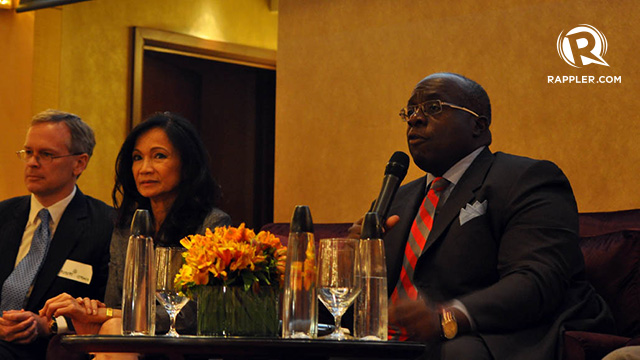SUMMARY
This is AI generated summarization, which may have errors. For context, always refer to the full article.

MANILA, Philippines – Despite ranking second-highest among Asian countries in 2012 annual growth, the Philippines still has a lot of catching up to make economic growth felt and enjoyed by the rest of the country’s population.
“We all know that the Philippines has now outpaced all the countries in the region in terms of economic growth,” said Gloria Steele, mission director of the United States Agency for International Development (USAID) in the Philippines.
The Philippine gross domestic product (GDP) grew by 6.8% in 2012.
Read: Philippines grows 6.8% in 2012
Philippine officials said they are confident the Philippines will breach the 7% GDP growth in 2013.
The country is now on pace to become Asia’s fastest growing economy.
Steele however said the bigger challenge is how to make the 42% of Filipinos who earn US$2 a day or less become key benefactor in the growth process.
Read: Who felt Philippines’ 7.8% gross domestic product surprise
The USAID top official in the Philippines said the country needs to create more employment opportunities and make inclusive growth happen.
US grants and aids
The US has stepped up grants and aids in the Philippines through the Partnership for Growth (PFG) project.
Its centerpiece program in the country is the US$434-million Millennium Challenge Corporation (MCC) that includes the rehabilitation of the 222-kilometer road in Samar and the multi-faceted Kalahi-CIDDS program that is “targeting communities where poverty exceeds the national average through small-scale and community driven development projects.”
Also a major component of MCC is the Revenue Administration Reform Project (RARP). The RARP aims “to narrow the gap between potential revenue collections’ by instituting reforms in the country’s internal revenues collection.
US Ambassador Harry K. Thomas Jr said, “Secretary (Hillary) Clinton took a chance on the Philippines when she created the Millennium Challenge Corporation.”
In November 2011, then Secretary of State Hillary Clinton and Philippine Foreign Affairs Secretary Albert del Rosario signed a P40-billion assistance package through PFG.
Improve ease of doing business
Thomas said he has faith in the Philippines and hopes to see the country achieve its inclusive growth target.
Thomas graced the regular Kapihan sa Embahada 2013 at the Raffles and Fermont Hotel in Makati last Tuesday, September 24.
The PFG project of the US also includes “fostering a more open and competitive business environment, strengthening rule of law and anti-corruption measures and improving fiscal performance.
Steele said the US wants to see the Philippines open up to foreign investments.
“(We are looking at) what industries we can work with in the local levels to create jobs.”
But she also said the government must also institute measures that will “reduce cost of doing business in the Philippines.”
Read: Improve ease of doing business in the Philippines, private sector told government
She also added that the Philippine government has “to address issues of lack of transparency and lack of integrity both in the government and private sectors.” – Rappler.com
Add a comment
How does this make you feel?
There are no comments yet. Add your comment to start the conversation.